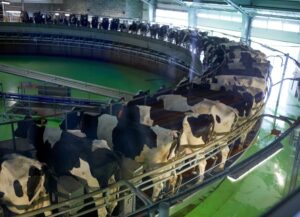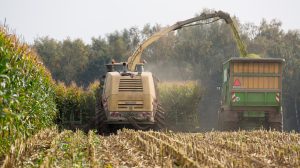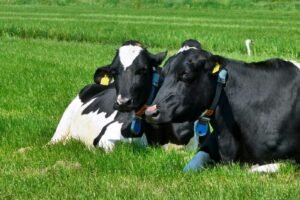Lucas Pantaleon
Leptospirosis is a disease of global importance caused by the bacterium Leptospira spp. This disease has significant impact on dairy cattle health and production. It is an important cause of reproduction failure, abortion and decreased milk production. Infected animals shed the bacteria in vaginal fluids and urine.
The disease in transmitted via exposure of mucous membranes or broken skin or to contaminated bodily fluids, water or soil. It is a zoonotic disease, thus humans that come in contact with the bacteria become infected, and dairy farmers are at particular risk. Vaccines for disease prevention are on the market, however they are not completely effective at preventing leptospirosis.
In gregarious species, animals are associated with each other in a non-random way, resulting in unevenly distributed social interactions. Improved knowledge of cattle contact structure, via social network analysis, could be a useful tool for improving the prevention of contagious infectious diseases on farms as well as improving animal welfare. Social network analysis is a tool that allows for the understanding and assessing the complexity of social relationships and provides a more precise understanding of the social and group structure of animals. Furthermore, this type of analysis could help to estimate the probability of occurrence of certain contact or to evaluate how different animal’s attributes lead to changes in animal contacts can impact network structures.
A recent work published in Applied Animal Behaviour Science focused on studying the social network effects around leptospirosis, more specifically transmission based on sexual risk behavior. The researchers hypothesized that the contact patterns between dairy cattle of the same group were influenced by individual cow attributes and structural properties of the social network.
Animals enrolled in the study consisted of a group of 170 milking cows and two weaned calf groups of 33 animals each. Animal were housed outdoors and kept in pasture-based systems year around. The contact behaviors studied were selected based on the likelihood of leptospira spp. transmission, and were: sniffing, licking and rubbing face on genital area of other animals. Behaviors were observed and recorded for 3 weeks in cows and 4 weeks in the weaned calf group.
In general, the animals studied in these herds had little interaction and contact with group members. Observations from this study revealed that networks were extremely sparse, this was despite the fact that most of the animals in each group were connected. Networks in this study were based on sexual behavior that are in turn determined by the reproductive cycle. For example, cows that were inseminated were twice as likely to interact as were pregnant cows. In the calves’ group males initiated social interaction more often and towards females.
Cows with more than 5 parities, had significantly more contacts than younger animals. This is an important finding since older cows are more likely to be infected by leptospira spp. and this greater interaction can aid with transmission.
Another interesting observation of the study was that newly entered calves or cows were more involved in contacts with other animals in the herd. This could have implications from the infectious disease point of view, because when an infected animal or animals with unknown health status is introduced to a herd, more frequent interactions would raise the risk for disease spreading.
This type of information on the sexual behavior patterns that could influence leptospirosis transmission in dairies are important to recognize and further investigate. Groups of connected animals are the ones with the highest risk of introducing and spreading a disease such as leptospirosis. Identification of those high-risk animals (females in estrus) is vital for targeted surveillance and biosecurity because animals with higher interaction could have an important role in transmitting infectious diseases among the herd. This contact structure should be taken into account not only for animal welfare reasons (group disruptions) but also to design more efficient biosecurity programs.
Reference
Inès de Freslon, Beatriz Martínez-López, Jaber Belkhiria, Ana Strappini, Gustavo Monti. 2019. Use of social network analysis to improve the understanding of social behaviour in dairy cattle and its impact on disease transmission. Applied Animal Behaviour Science. 212: 47-54.
© 2019 Dairy Knowledge Center, LLC. All Rights Reserved.









